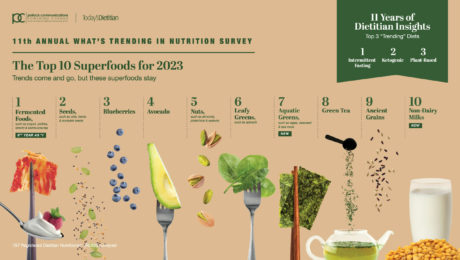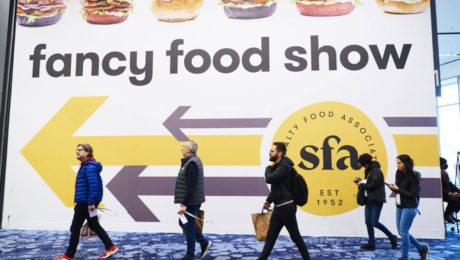Fermented Foods No. 1 for 6th Year
Fermented foods take the top spot in Today’s Dietitian annual list of superfoods for the 6th year in a row.
Registered Dietitian Nutritionists (RDNs) were polled by Today’s Dietitian and Pollock Communications on their views on superfood predictions and grocery shopping habits. The results, published in the 11th annual “What’s Trending in Nutrition” survey, predict how and what consumers will eat. Since 2019, health became the key focus of the superfood list. Striking this year is the new focus on affordable and accessible food.
“After years of keeping immune health and comfort top-of-mind during the COVID-19 pandemic, consumers are back to prioritizing affordability and convenience when shopping for food,” Pollock Communications shared in a statement.
This shift is attributed to the higher cost of groceries “as consumers navigate the cost-of-living crisis.” RDNs predict top purchase drivers are affordability and value (70.4%), ease of accessibility and convenience (59.1%) and immunity support (57.6%).
“Consumers are more aware than ever of the benefits food can provide for gut health and immune function. As consumers face higher costs at the grocery store, they’ll be looking for affordable food and snacks that still provide valuable health benefits,” says Louise Pollock, president of Pollock Communications. “Our survey findings reflect how consumer behaviors are shifting as Covid-19 restrictions loosen, remote work remains and inflation rises – from prioritizing affordable foods to continued interest in snacking.”
The survey highlights fermented food products yogurt, kimchi, kombucha and pickled vegetables. Also noteworthy is that, for the first time in 11 years of conducting the survey, the entire superfoods list is plant-based. The top ten include:
- Fermented Foods
- Seeds, such as chia and hemp
- Blueberries
- Avocados
- Nuts, including pistachios, almonds and walnuts
- Leafy Greens, such as spinach
- Aquatic Greens, such as algae, seaweed and sea moss
- Green Tea
- Ancient Grains
- Non-Dairy Milks
Plant-based diets are becoming more popular, and RDNs note it’s the third most popular diet after intermittent fasting and keto. However, only 1% of RDNs say they would recommend meat alternatives because they are highly processed products.
RDNs are also concerned about where consumers are getting their nutrition information. Social media platforms such as TikTok, Instagram and Facebook are “rife with nutrition misinformation,” but they’re where many consumers turn for nutrition advice.
“Social media influencers are talking about wellness and nutrition at rates never seen before, but people struggle to differentiate between credible information and myths. This only supports the need to amplify credible sources of nutrition information, like registered dietitian nutritionists,” says Mara Honicker, publisher of Today’s Dietitian. “With the survey in its 11th year, we are excited to continue to share insights from these experts in food and nutrition, at a time where the value of food is subject to more scrutiny.”
- Published in Health
FDA: Pickles & Yogurt “Unhealthy”?
Pickle and yogurt brands are speaking out against new labeling rules proposed by the U.S. Food and Drug Administration. The FDA’s new guidelines say some brands of the fermented products cannot be marketed as healthy because pickles are too salty, while some yogurt has too much sugar.
The guidelines are being updated for the first time since the 90’s. They redefine what can be labeled as “healthy” on a food package. Healthy products have high amounts of key nutritious ingredients, like fruits and vegetables, and low amounts of added sugar, sodium and/or saturated fat. Those updated nutrient content claims would go into effect in 2026. They wouldn’t ban “unhealthy” foods, but prevent the use of “healthy” on a label.
“Pickles have a role to play in a healthy diet because they are predominantly comprised of vegetables and serve as a delicious condiment to other nutrient-dense foods,” Pickle Packers International said in a statement.
Though pickles are made from low-sodium cucumbers, they are either fermented through a brine made of water, salt and seasonings or preserved in a brine of vinegar, salt and seasonings. Without enough salt in the brine, bacteria can grow and spoil the pickles. The new guidelines put the limit for sodium from a vegetable product at 10% of the daily value per serving (230 milligrams per serving). But most pickles include 11% sodium per serving.
Yogurt, too, is under fire. The new guidelines outline that a ¾ cup of yogurt should only include 5% per serving of the daily value of sugar (2.5 grams of added sugar per serving). Chobani’s plain greek yogurt includes 5.5 grams of sugar per serving. Chobani has actively protested the FDA’s ruling, noting that “reducing sugars to the level proposed by FDA for the ‘healthy’ claim would result in significant, deleterious effects to product quality, taste, and texture.”
Other companies are protesting the FDA’s guidelines – like General Mills, Kellogg’s, SNA International, the National Pasta Association and the Consumer Brands Association. The FDA guidelines put tighter restrictions on cereal and pasta, too.
“Hardly anything would qualify, so of course food manufacturers don’t like the idea,” says Marion Nestle, emeritus professor of nutrition and public health at New York University. She told nutrition and medicine publication STAT that the FDA’s regulation “automatically excludes the vast majority of heavily processed foods in supermarkets, as well as a lot of plant-based meat, eggs, and dairy products,” from bearing the healthy claim.
The publication notes nutrition experts gave “overwhelmingly positive remarks.” The new guidelines are supported by the American Society for Nutrition, the Association of State Public Health Nutritionists and the Robert Wood Johnson Foundation. Some experts argued the GDA could go further in restricting the healthy label.
Read more (STAT)
- Published in Food & Flavor, Health
Japan Turns to Fermented Foods for Food Waste Solution
In Japan, more and more food producers are turning to fermentation as a cost-effective and nutritious way to give new life to food waste. It comes at a critical time, as the Japanese government has made an ambitious plan to halve food waste by 2030.
Fermentation has deep-rooted tradition in Japan, where kōji-based products like miso and sake were first made centuries ago (pictured, students in a miso class mix soybeans with kōji rice and salt). Japan Times outlines how Japanese producers are experimenting with fermentation to combat climate change:
- For example, multiple Japanese beermakers are using food scraps in their brewing. Chiba Upcycling Lab is using bread waste, Rise & Win brewery uses yuzu peel and Ashai uses spent coffee grounds.
- The Japan Food Ecology Center produces pig feed using lactic acid bacteria to ferment 39 metric tons of food scraps a day that come from 180 businesses.
- Tokyo-based Food Alchemist Lab is making plant-based salami using kōji, nuts and vegetable fibers, including juice production scraps.
Key is “combining ancient fermentation knowledge with novel approaches,” the article continues.
“Microorganisms have given us miso, sake and soy sauce. Now they can help save the planet,” says Tomas Linder, associate professor and senior lecturer in microbiology at the Swedish University of Agricultural Sciences in Uppsala.
Read more (Japan Times)
- Published in Business, Food & Flavor
Bringing Injera to U.S. Diners
A California-based Ethiopian chef is making some creative takeout offerings. Serkaddis Alemu of Santa Barbara Ethiopian restaurant Petit Valentien now sells DIY injera kits, for customers to create the fermented flatbread at home.
“Don’t call it bread; don’t call it crȇpes: Injera is injera,” Alemu says (pictured with her husband and daughters). “With fermentation, you really can’t cut corners.”
Injera is a spongy, sour, pancake-like flatbread. It is made of teff flour, a nutrient-dense flour that grows in the highlands of Ethiopia. Injera is a staple in Ethiopia, and TFA predicts it’s poised to become a popular fermented food in the U.S.
The $49 kit contains an instructional guide, video links, one pound of ivory teff, one pound of brown teff and Alemu’s mother dough.
Alemu says slowing down will be the biggest challenge for some home cooks making their own injera. Fermentation of injera takes between one and six days, depending on the desired flavor outcome. She hopes the kit will help inspire others to ferment.
Read more (Santa Barbara Independent)
- Published in Food & Flavor
Exploring Fermentation & Health with David Zilber
We cannot write-off pasteurized ferments as the dead, less healthy cousin to its unpasteurized, live relative. All fermented foods provide health benefits, pasteurized or not. We also need to avoid getting caught up in superfluous health claims around fermentation’s benefits. Instead, we should focus on including fermentation as part of a regular diet.
David Zilber explored how the microbial transformation of food intersects with our gut microbes during Stanford University’s Center for Human Microbiome Studies Fermentation & Health Speaker Series. With growing scientific interest in fermentation – and increasing interest from consumers – the health benefits become cloudy in marketing claims.
“If you eat regularly foods full of life, life that lives regularly in the foods you consume but also inside of you, then you can be said to be a ranger taking care of a healthy forest,” Zilber said. “The health benefits of fermented foods should equally be viewed as being meaningful when they turn into a regimen, like exercise.”
Health Claims
A 2021 study by Stanford researchers published in the journal Cell found regularly eating fermented foods boost microbiome diversity, improves immune response and decreases inflammation. But marketing of fermented products is often shrouded in hearsay.
“As far as health claims go…(there are) sometimes outlandish claims made by Westerners about cure-all superfoods that disproportionately, and I quote from one study I found, ‘Seemed to benefit the individuals that sell them the most,’” Zilber said.
Take kombucha, for example. He rattled off a list of health problems kombucha founders have claimed the fermented tea has cured, from AIDS to cancer to constipation.
“The problem is that all these claims seem to come, in one form or another, from anecdotes of people who drink kombucha and have lived a life,” he added. They’re not researched in reputable cohort studies. “This is why it’s sometimes hard to separate the wheat from the chaff when it comes to fermentation. The people who want to believe the benefits only decry its Praises when a positive correlation is made but they also tend to speak the loudest.”
Zilber pointed out that consuming fermented foods, whether or not it’s a product with proven health benefits, is certainly still beneficial. Eating fermented foods regularly means “you’re also omitting a whole slew of other foods” prevalent in a Western diet, like highly-processed and chemically-preserved foods.
“If you put kimchi on your plate at dinner, you leave off mashed potatoes. If you use water kefir as your drink with it, you aren’t drinking Coke,” he said. “And that’s an important link we also can’t forget, when it comes to thinking about the health benefits of fermented foods, they are in many means inherently healthy.”
Many cultures have fermented for thousands of years to preserve food. In Tibet, yak herders rely on cultural wisdom passed down from generations to ferment yak’s milk for milk and butter.
“We’ve evolved alongside our microbes both evolutionarily and culturally,” Zilber added. “To Tibetans their folk knowledge of what leads them to Long lives and health is intrinsically tied to the practices of preservation that have allowed them to thrive in some of the most rarified air on Earth.”
Pasteurized vs. Unpasteurized
What about purchasing pasteurized vs. unpasteurized ferments? Unpasteurized ferments include live microbes, but that doesn’t mean pasteurized ferments aren’t healthy.
“Sometimes in cooking, if you’re looking to achieve a great flavor, sometimes you have to kill microbes because you have to pasteurize them for whatever number of reasons,” Zilber added. But it doesn’t mean that the food is somehow not worth eating, it just means that it’s not live, but it still contains lots of benefits. … There is a benefit to consuming something that microbes have lived through, even if it’s not pasteurized.”
Elisa Caffrey, the speaker series host and a Stanford PhD candidate, agrees. The benefits of unpasteurized ferments have not been studied. During fermentation, Caffrey notes, the microbes are producing metabolites still present during pasteurization. A complete study would characterize the metabolites over the course of the fermentation process, identify chemical compounds and then analyze the compounds for their benefits.
“That landscape we don’t understand at all and it’s a very, very interesting world to start exploring,” she said. “Until we start understanding all the different components of these foods and the way that they interact with not only the microbes in fermented foods with each other but also with the body, it’s really hard to then make these very generalized health claims.”
Caffrey, Zilber and Justin Sonnenburg, PhD, professor of microbiology and immunology at Stanford, host the Fermentation & Health Speaker Series. The series will explore the topic over the next few months with different speakers ranging from a scientist, food researcher and pickle producer. Registration is free.
Fermentation is Not a Trend
Fermentation intersects several major food movements – it’s natural, artisanal, sustainable, innovative, functional, global, flavorful and healthy. Now is an ideal time in the food market for fermentation producers.
“Fermentation is not a trend. It’s experiencing a resurgence, a renaissance,” says Amelia Nielson-Stowell, editor of The Fermentation Association. “Fermentation never went away. It just became less of a common type of food craft, especially in the U.S. where Americans became accustomed to other types of food processing.”
Nielson-Stowell was a speaker at the Specialty Food Association’s Winter Fancy Food Show in Las Vegas. Her remarks touched on growth opportunities and challenges for the fermentation industry. It was well-received by the audience. Two food business news magazines wrote articles about it. The show’s keynote speaker, author Paco Underhill, was also in attendance and brought up Nielson-Stowell’s presentation during his keynote.
Fermentation is a growing industry, slated to reach $846 billion in global sales by 2027. Kvass, pickles, kimchi and hard cider are the products experiencing the largest growth.
There’s no denying fermentation’s popularity – “there’s widespread scientific agreement that eating fermented foods will help the microorganisms in your gut,” Nielson-Stowell explains. But reputable clinical trials proving the health benefits of fermented foods are few and far between because they’re incredibly expensive to conduct. There are plenty of studies on the health benefits of yogurt because there’s a lot of money in the dairy industry. Other ferments don’t have the monetary backing, she adds.
Nielson-Stowell points to the 2021 Stanford study as a “watershed moment” in fermentation. It’s one of the first clinical trials proving diet remodels the gut microbiota. The research, published in the journal Cell, found a diet high in fermented food like yogurt, kefir, cottage cheese, kimchi, kombucha, fermented veggies and fermented veggie broth led to an increase in overall microbial diversity.
“This microbiome world we are in right now is a real opportune time to talk to consumers about fermented foods and health,” Nielson-Stowell said. “Humans have long consumed fermented foods for thousands and thousands of years, but now we have the scientific techniques to dive into fermented foods and analyze their nutritional properties, their microbial composition and better understand how they may improve a person’s health.”
Educating consumers is another major challenge. Nielsen-Stowell encourages brands to focus on simple messaging, then delve deeper into the science on their webpage for consumer’s that want to know more about the intricacies of their food.
“Many consumers are confused about fermentation. They know it’s good for them, but they don’t understand why or what products are fermented,” she said.
Tradition, too, should be shared.
“Fermented foods have a unique story to them compared to other foods,” she adds. “Every culture in the world has a traditional ferment. We are here today because, thousands of years ago, our ancestors fermented.”
- Published in Food & Flavor, Health
Food and Beverage Laws Passed in 2022, Part 2
Evident of the desire to help local businesses bounce back from the pandemic, the remainder of food legislation passed in 2022 was aimed at helping businesses — especially brewers. Outdated alcohol beverage laws revamped in many states and many cottage food producers can sell homemade food with less restrictions.
In our last newsletter, we shared the food and beverage laws passed in the first half of the United States in 2022. The list below completes the balance of the country — Massachusetts to Wyoming.
Michigan
HB4232 — Aids small businesses in filling labor shortages in restaurants by expanding eligible workforce to allow 17-year-olds to waitstaff to sell and serve alcohol.
HB5695 — Amends Michigan Liquor Control Code to allow a minor employee who is at least 16 years old to build a display of certain brands of alcohol, mark the price on those brands, rotate them and place them on shelves.
HB5696 — Amends the Youth Employment Standards Act to allow a minor to be issued a work permit for employment with an establishment where alcoholic beverages are distributed.
HB5744 — Codifies the licensure and regulation of certain persons engaged in processing, manufacturing, production, packing, preparing, repacking, canning, preserving, freezing, fabricating, storing, selling, serving, or offering for sale food or drink for human consumption;
HB5747 — Allows for a certificate of free sale from the Michigan Department of Agriculture and Rural Development (MDARD) for milk and dairy products.
HB6105 — Allows alcohol wholesalers to distribute non-alcoholic beverages to retailers and allows use of electronic coupons under certain circumstances.
HB6106 — Allows wineries and breweries to make and sell private label products.
HB5984 — Allows the consumption and service of food, beverages and alcohol in public swimming pools.
SB656 — An act to create a commission for the control of the alcoholic beverage traffic within this state.
Minnesota
HB918 — Creates a Food Truck Permit under the local alcoholic beverage control law, allowing food truck vendors to sell alcoholic beverages.
SB2844 — Provides funding to construct the Mississippi Alcoholic Beverage Control Warehouse.
SB3008 — Makes several changes to Minnesota’s liquor laws. Known as the “Free the Growler” bill, the new law raises the cap on growler sales. It also allows more off-sale options for smaller breweries and expands license opportunities for specific cities and events.
Mississippi
HB684 — The state’s Small Business and Grocer Investment Act. Develops quality retail food outlets for jobs, expands markets for Mississippi farmers, supports economic vitality in underserved communities. Increases access to retail food outlets that sell fresh and healthy food. Provides a dedicated source of financing for healthy food retailers in Mississippi.
HB1135 — Allows home delivery of alcoholic beverages from licensed retailers.
SB3015 — Earmarks funds for the State Department of Agriculture and Commerce, including costs of the Farmers Central Market.
Missouri
HB1697 — Allows cottage food producers to sell food over the internet. Removes the $50,000 annual sales limit for cottage food producers.
New Hampshire
HB314 — Raises the maximum annual gross sales of food by a homestead or cottage food operation from $20,000 to $35,000.
HB1039 — Amends alcohol law, allowing beverage manufacturers to sell beers made on-site to state-based wholesalers.
HB1584 — Establishes a capital improvement grant program for the benefit of state fairs and agricultural fairs.
SB17 — Allows dogs in outdoor dining areas.
SB212 — Lowers liquor license fee to $300 (from $1,692) for brewers selling less than 1,000 cases of liquor per year.
New Jersey
AB462 — Permits pedicabs to operate while passengers are consuming alcoholic beverages.
AB3991 — Exempts raw, unprocessed honey from the health department’s cottage food regulations.
New York
AB2344 — Requires food service establishments to post food allergens at restaurants and in food ordering services.
AB3954 — Establishes New York State Council on Food Policy. Establishes policies to help New Yorkers avoid food insecurity and eat as much New York-grown and produced food as possible. Supports growth of a New York-based local farm and food product economy to revitalize rural, suburban and urban farms.
AB8620 — Authorizes a licensee to sell wine for consumption on the premises to also include the sale and consumption of shochu (Japanese alcoholic beverage).
AB10176 — Allows alcohol license holders to sell liquor at off-premise catering establishments.
SB771 — Amends the Nourish New York program to define products as those grown, produced, harvested, butchered, canned or freezed in New York.
SB5438 — Amends alcohol beverage control law to authorize tastings at licensed premises by distillers.
SB7655 — Amends the definition of New York State-labeled beer to require that at least 60%, by weight, of its hops and at least 60% of any other ingredients are grown in New York.
SB7823 — Creates an advisory group which will produce a report on improving urban and rural consumer access to locally produced, healthy foods.
SB8989 — Authorizes the manufacture of beer, spirits, cider, wine and mead at the Culinary Institute of America.
SB9093 — Amends alcohol beverage control law to allow parcels of land to the list of premises which are exempt from the law’s provisions. Restricts manufacturers/wholesalers and retailers from sharing an interest in a liquor license.
SB9385 — Amends alcohol beverage control law to allow a restaurant located within 200 feet of a school to serve alcohol.
North Carolina
HB768 — The 2022 ABC Omnibus, decreases regulations on bar owners and expands the freedom of alcohol sales and transportations. Eliminates the $1 membership requirement for people at visiting private bars.
SB762 — North Carolina Farm Act of 2022.
Ohio
HB629 — Increases microdistillery production limits and allows spirituous liquor tasting samples at agency stores free of charge.
SB102 — Modifies Ohio’s liquor laws. Eases restrictions on local homebrewers and fermenters, exempting them from certain liquor law permits. Allows homebrewers to make beer or wine without a liquor permit, serving it on private property for personal consumption. Homebrewers cannot sell homemade beer or wine. Permits a person under the age of 18 to handle beer and liquor at a hotel, bar or restaurant. Eliminates provision that more than 30% of a restaurant gift card could not be used to purchase alcohol. Authorizes a retail liquor permit holder to sell beer or liquor on Sunday. Allows charitable or political organizations to give away beer or liquor as a prize at a raffle or auction.
Oklahoma
SB269 — Allows a mixed-beverage licensee selling wine, beer or cocktails to-go to provide a different price than they do for drinks that are served on premises.
SB757 — Allows for small brewer and small farm wineries to deliver alcohol.
Pennsylvania
HB1615 — Allows breweries to sell malt or brewers beverages to non-licensees and licensees that also sell malt or brewers beverages. Allows all liquor license holders to offer amplified sound in their establishment (previously only allowed for wineries).
Rhode Island
HB7095 — Part of the “Take It Outside” campaign, allows restaurants to continue approved outdoor dining, which was originally approved only for the pandemic. Extends moratorium on municipal enforcement of outdoor dining requirements.
HB7209 — Eliminates sunset date on the law that allowed takeout drinks. The new law now permanently allows Class B liquor license holders and brewpubs to sell distilled spirits with takeout orders.
HB7438 — The Toxic Packaging Reduction Act, prohibits food packaging with PFAS intentionally added in any amount from being manufactured, knowingly sold or distributed in Rhode Island, as of Jan. 1, 2024.
South Dakota
HB1322 — Expands definition of cottage food to include all shelf-stable foods, and even some foods requiring refrigeration, provided the seller completes regular food-safety training. Cottage food producers will still be required to label items with a product name, the name of the producer and a disclaimer that it wasn’t produced in a commercial kitchen.
SB101 — Allows any person 19 years or older, who is certified by a nationally recognized alcohol management program, to draw, pour, mix, serve and sell alcoholic beverages if the licensee is at least 21 years of age and on the premise when the alcohol is being served.
SB188 — Allows for unlicensed businesses to store alcoholic beverages.
Tennessee
HB1688 — Creates a common carrier license to be issued by the alcoholic beverage commission to a person or corporation that transports alcoholic beverages for a fee.
SB693 — Enacts the Tennessee Food Freedom Act, specifying circumstances when persons may sell certain homemade food products. Allows people to sell shelf-stable food products without a license, as long as they don’t require temperature control.
SB2270 — Authorizes a special occasion license to designate an area in which liquor-by-the-drink licensees may sell alcoholic beverages and beer to patrons who may consume the alcoholic beverages and beer anywhere in the designated area. Authorizes a festival operator licensee to provide a list of the liquor-by-the-drink licensees that will sell alcoholic beverages and beer to patrons in the designated area of the festival.
Utah
HB142 — Allows wild game to be donated to food banks and charitable organizations.
Virginia
HB426 — Creates a third-party delivery license that authorizes the licensee to deliver alcoholic beverages purchased by consumers from other retail licensees.
HB837 — Requires any food manufacturer, food storage warehouse, and retail food establishment to obtain a permit from the Commissioner of Agriculture and Consumer Services prior to operating.
HB1336 — Convenes a working group from representatives of the state’s alcoholic beverage control authority, Virginia Wineries Association, the Virginia Wine Wholesalers Association, the Virginia Beer Wholesalers Association, and the Virginia Craft Brewers Guild and other relevant stakeholders to address various needs, including evaluating the number of barrels of beer allowed under a license and reviewing distributing through the Virginia Winery Distribution Company.
SB146 — Guarantees that State Board of Health regulations should not require an establishment that only sells prepared foods to have a certified food protection manager on site during all hours of operation.
SB315 — Increases the amount of alcoholic beverages that can be transported through the state from one gallon to three gallons.
SB519 — Authorizes sale and service of alcoholic beverages for casinos.
Washington
HB1145 — Allows non-wood, renewable fiber in 2 recycled content paper carryout bags.
HB1359 — In light of the ongoing Covid-19 pandemic, reduces liquor licensing fees temporarily.
SB5619 — Conserves and restores kelp forests and eelgrass meadows in Washington State.
- Published in Business
“Fermented Foods…Democratize the Science”
Though research about the gut-brain axis is a “growing, pioneering and still relatively novel field,” scientists say humans can improve their mental health by eating a balanced diet rich in fermented foods.
Changes in the gut microbiome can impact the brain’s behavior. Research advancements in the last 20 years “suggest that these (gut) microorganisms aren’t just a vital part of our physical selves, but also our mental and emotional selves, too.” This can be a major breakthrough in how mental health is treated.
For example, one study found individuals with depression have different gut bacteria compared to individuals without depression. Those without depression have a higher amount of bacteria associated with better wellbeing and quality of life. Antidepressants didn’t help. Another study found taking certain probiotic strains improve symptoms of depression and anxiety. And yet another study found taking prebiotics improved the brain’s cognitive function.
But research is still in its early stages. Though some strains of bacteria have been scientifically proven “to have a positive effect on the human mind,” researchers don’t know why and how. Genetics, personality and environmental factors have also not been studied. More large-scale human studies are needed – and those studies are extremely expensive.
In the meantime, John Cryan, a professor of anatomy and neuroscience at University College Cork, encourages people to eat a diet high in fiber, prebiotics and fermented foods. A study by Cryan and his colleagues found that diet
Cryan and his colleagues studies 45 people eating that diet and found they were less stressed than the control group.
“What I like about fermented foods is that they democratize the science,” says Cryan. “They don’t really cost much and you don’t have to get them from some fancy store. You can do it yourself. In this field, we want to provide mental health solutions to people from all socioeconomic areas.”
Read more (BBC)
- Published in Science
Noma Announces End of Restaurant; Hires for Food Lab
Noma – the New Nordic restaurant that inspired the restaurant fermentation movement – announced it will be closing in 2024, reopening as a food lab. This reiteration (owner René Redzepi calls it Noma 3.0) will focus on developing new dishes and products for Noma Projects, Noma’s e-commerce, CPG operation.
Within days of the news, Noma announced the hire of Arielle Johnson, PhD, as Noma Projects’ Science Director. Johnson, a flavor scientist, food chemist and gastronomy researcher, co-founded the Noma Fermentation Lab in 2014.
Since first opening two decades ago, Noma has been named one of the world’s best restaurants. The announcement shocked the restaurant industry as Noma is seemingly at the top of their game. Noma redefined fine dining – meals at Noma were largely local, Nordic ingredients turned into artistically beautiful and culinarily unique dishes.
“The style of fine dining that Noma helped create and promote around the globe — wildly innovative, labor-intensive and vastly expensive — may be undergoing a sustainability crisis,” writes the New York Times.
Redzepi himself says the long hours and fair compensation for the large team “is not workable.” Noma came under fire for their stagiaire program, the term for unpaid restaurant interns. Noma started paying their interns in October 2022.
“We have to completely rethink the industry,” he told the Times. “This is simply too hard, and we have to work in a different way.”
“Fine dining is at a crossroads, and there have to be huge changes,” he said. “The whole industry realizes that, but they do not know how it’s going to come out.”
Read more (New York Times)
- Published in Business, Food & Flavor
Bringing Vietnamese Ferments to the U.S.
When demand in Vietnam for Song Huong Foods (SHG) fermented foods began to wane, brand owner Nguyen Le Quoc Tuan decided to take the brand overseas.
The 20-year-old ferments company is most famous for their ferments, like pickles, seafood, eggplant, sauces and pastes. But, after the pandemic, a number of Vietnamese stores selling SHG products shut down. So Tuan, knowing Vietnamese expats love to eat Vietnamese specialties, turned to U.S. exports.
After six months of food safety tests and certification from the U.S. FDA, SHG released in 32 U.S. states in December 2022, “just before the upcoming Lunar New Year,” Tuan said.
Their distributor, CTWS Group, an Asian food wholesale distributor, said it’s the first time fermented products from Vietnam are sold in the U.S.
Local production has been a challenge, so supplies are still sourced from Vietnam. Tuan’s goal is to expand in the U.S., eventually selling in Costco, then export to Japan, Taiwan, Australia, Russia and China.
Read more (VnExpress)
- Published in Business










